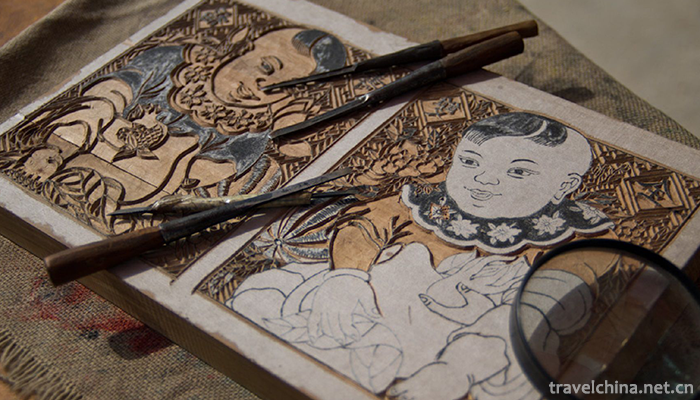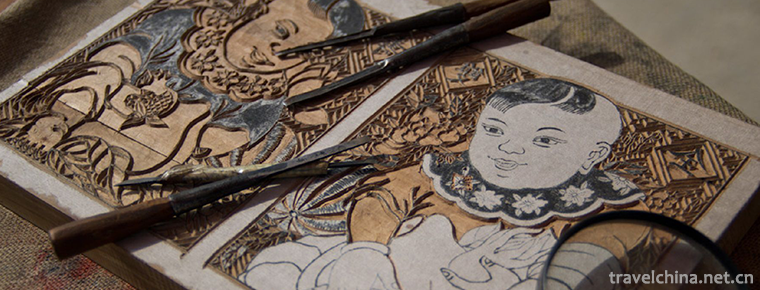Yang Liu Qingmu New Year Print
Yang Liu Qingmu New Year Print
Yangliuqing Wood Printing New Year Picture, Tianjin folk traditional art, one of the national intangible cultural heritage.
According to legend, Yangliuqing woodcut New Year pictures began in Wanli period of Ming Dynasty and flourished in the middle of Qing Dynasty. Yangliu Qingmu New Year Print has a wide range of themes, rich content, full composition, auspicious implication, elegant and popular appreciation. It uses the combination of carving and painting, exquisite carving, delicate drawing, vivid characters, elegant color.
On May 20, 2006, the Yangliuqing woodcut New Year pictures were approved by the State Council of the People's Republic of China and listed in the first batch of national intangible cultural heritage list.
historical origin
According to legend, the Yangliuqing woodcut New Year pictures started in Wanli period of Ming Dynasty. The painting shops are Dai Lianzeng and Qi Jianlong. They may all be painters at first, and they are named after the shop by their names. The history of Dai Lian Zeng Painting Shop can be traced back to Chongzhen period of Ming Dynasty. Later, Dai and Qi systems were divided into many painting shops, the important ones were "Lian Zeng, Beauty, Lian Zeng Li; Jianlong, Huilong, Jianhuilong".
Yangliuqing wood engraving production flourished in the mid-Qing Dynasty and developed into Yangliuqing Town as the center. It also includes 32 villages in Nanxiang (Yangliuqing, Zhoujiazhuang, Lijiazhuang, Zhaojiazhuang, Gufo Temple, fried rice shop, wood factory, Feng Gaozhuang, Guojiazhuang, Daduzhuang, Xiaoduzhuang, Xuanjiayuan, Bijiacun, Xiaodianzi Village, Gongjiazhuang, etc.). Yanjiazhuang, Kangzhuang, Fangjiazhuang, Dongxiliucheng Village, Laojuntang, Yuejiakai, Wangjiacun, Dashawo, Xiaoshawo, Xinkou Village and Zhengjiazhuang) all print New Year pictures.
At the end of the Qing Dynasty and the beginning of the Republic of China, the countryside was depressed, the stone-print New Year's Painting was rising, and the production of Yangliu Youth Painting was declining day by day, but there were still sixteen or seven painting shops (such as Dai Lian Zengjin Ji, Wanshengheng, Wanshengchang, Dai Lianzeng, Lian Zengdai Ji, Yishun, Dai Mei, Qinghe, Yuwan, etc.).
After the broad invasion of the Japanese military, Yangliuqing Youth Painting was greatly damaged in production and sales. Painting shops closed down one after another. Some of them were reluctantly maintained mainly by inscription code, and were on the verge of extinction of artists before liberation.
During the War of Resistance Against Japan, owing to the war, some precious ancient editions of Yangliuqing were damaged countless, and Yangliuqing woodcut New Year pictures were on the verge of extinction.
In 1953, Tianjin Cultural Bureau organized the old artists to set up the "Yang Liu Youth Painting Production Mutual Assistance Group" and resumed the production of New Year's Painting.
In 1958, with the approval of the Tianjin Municipal People's Government, Tianjin Yangliuqing Painting Shop was established (which was formed by Tianjin Deyu Gong Painting House, Tianjin Rongbaozhai and Yangliuqing Youth Painting Workshop, and later renamed Tianjin Yangliuqing Painting Society) to carry out special protection and excavation of Yangliuqing New Year Printing.
Cultural characteristics
Yangliuqing woodcut New Year's Painting is a Folk Woodcut New Year's Painting in China. It inherits the traditions of Song and Yuan Dynasty, absorbs the forms of woodcut, arts and crafts, theatre stage in Ming Dynasty, and combines woodcut overprinting with hand-painted painting to create a distinctive style with vivid, joyful and auspicious and touching themes.
Yangliuqing wood engraving New Year pictures are rich in content. By the end of 2010, there are more than 2000 kinds of pictures preserved in Yangliuqing wood engraving New Year pictures. Among them, there are people who praise (in historical stories) the rule of the world, loyal ministers, saints and virtuous gentlemen, honest officials and good generals. They also criticize the evil acts of comatose lords losing their country, treacherous ministers playing power, evil officials embezzlement, etc. They also publicize the thought of retribution for cause and effect in mythological stories, such as showing good mothers and godsons, filial daughters, heroic rescue, chivalrous and guests. Face to face, there are vivid depictions of various secular figures, such as Lin Quan Gaoshi, patriotic and benevolent people, good teachers and scholars, Yuanzi Yuweng, farmer and Weaver girl, medical divination astrology, monks and Taoists, masters of qin, chess, calligraphy and painting, there are descriptions of famous mountain scenery, current events, news and other subjects, outlining the wheel of the secular folk customs of the Chinese nation for nearly a thousand years. The outline is like a complete picture of folk life. Yangliuqing woodcut New Year pictures have various themes, including historical stories, opera characters, gods of wealth, beauty, fat dolls, pavilions, animals, flowers, Bogu and ten kinds of brocades, auspicious rich and noble patterns, which imply festivity and auspiciousness.
Yangliuqingmu New Year's prints are rich in composition, neat in brushwork and bright in colour. Most of the important parts of the figure's head, face and clothing are dyed with powder and golden halo. They have a unique style. They are greatly influenced by traditional paintings and Northern engraving illustrations. In terms of plate making, there are two kinds: Spring Edition and autumn edition. The Spring Edition is fine and the Autumn Edition is rough. Carving is characterized by the combination of woodblock overprinting and hand-painted, unique style, popular with the masses.
Production process
The production process of Yangliuqing wood engraving New Year pictures is roughly as follows: manuscript creation, plate division, engraving, overprint, color painting, mounting. Pre-process is similar to other woodcut New Year pictures, which are based on the overprint of the draft. However, the post-production of Yangliuqing Wood New Year pictures spends a lot of process in hand-painted, which integrates the flavor of the woodcut with the tone of the brush strokes of the painting and makes the two arts complement each other skillfully.
When making Yangliuqing New Year's Wood Print, the picture lines are first carved with woodcut, then printed on it with ink. After two monochrome plates, the picture is filled with colored pens. There are not only plate flavor, wood flavor, but also hand-painted colorful and craftsmanship. Therefore, folk art has strong charm and rich Chinese style.
Subject works
Tianjin Yangliu Qingmu New Year Print has a wide range of subjects, involving politics, economy, military, religion, philosophy, geography, sociology, folklore, literature, art and many other fields. The materials are very extensive, such as historical stories, myths and legends, opera characters, secular customs and landscape flowers and birds, especially those closely related to people's lives.
For example, Busy Crops, Festival of Lantern Festival, Late Festival of the Qiujiang River, Visiting Old Knowledge with One South Village, Happy New Year, Happy Family, Fisherwoman, Women's Studying, Civilized Marriage and Pawnshop Grabbing, etc.
Inheritance and Protection
Inheritance value
Yangliuqing Wood Printing New Year Picture has created a distinctive style with vivid, happy and auspicious, touching theme. In the history of Chinese printmaking, Yangliu Youth Painting and the famous Southern Taohuawu New Year Painting in Suzhou are called "South Peach and North Willow".
Yangliuqingmu New Year Print is the representative of Chinese New Year Picture Art, which occupies an important position in the development history of Chinese folk culture and Tianjin culture. The excavation, rescue and protection of Yangliuqing wood engraving New Year pictures are of great significance to the study of Tianjin folk culture, northern New Year pictures and even the development of Chinese art.
Heritage figures
Huo Qingshun, male, was born in November 1952. In June 2007, Huo Qingshun was selected as the representative successor of the first batch of national intangible cultural heritage projects and declared by Tianjin. Project Name: Yangliuqing Wood Engraving New Year Picture.
Huo Qingyou, male, was born in 1954. In June 2007, Huo Qingyou was selected as the representative successor of the first batch of national intangible cultural heritage projects and declared by Tianjin. Project Name: Yangliuqing Wood Engraving New Year Picture.
Feng Qingzhong, male, was born in June 1944. In June 2007, Feng Qingquan was selected as the representative successor of the first batch of national intangible cultural heritage projects and declared by Tianjin. Project Name: Yangliuqing Wood Engraving New Year Picture.
Wang Wenda, male, was born in December 1944. In June 2007, Wang Wenda was selected as the representative successor of the first batch of national intangible cultural heritage projects and declared in Tianjin. Project Name: Yangliuqing Wood Engraving New Year Picture.
protective measures
Tianjin Yangliuqingmu New Year Print Museum is one of the 20 popular projects in Tianjin. The project was completed on July 14, 2011. Its main purpose is to protect, save and develop Tianjin Yangliuqingmu New Year Print.
social influence
Important activities
On September 2, 2017, China Tourism Industry Exposition was held in Meijiang International Convention and Exhibition Center. In Xiqing Tourism Products Promotion Exhibition Area, a teacher demonstrated the production process of Yangliuqing Wood Print New Year Picture.
On June 10, 2017, on the first "Cultural and Natural Heritage Day" in China, Huo Qingshun, the successor of Yangliuqing wood block New Year Painting, showed the audience the production process of Yangliuqing wood block New Year Painting.


-
2.Boiled Chinese flowering cabbage
Boiled cabbage is a traditional dish in Guangdong province. It is a Cantonese cuisine. This dish is crisp and tender in quality, unique in flavor and rich in nutrition.
Time 2018-11-02 -
3.Beijing Planning Exhibition Hall
Beijing Planning Exhibition Hall, located in Qianmen East Street (east side of old Beijing Railway Station) of Dongcheng District of Beijing, is renovated on the basis of the original building.
Time 2018-12-26 -
4.Yongquan Qicheng Great Wall Ecological Scenic Area
The Great Wall of Yongquan Qi is a quiet tourist scenic spot, located in Yongquan Village, Zihe Town, Zibo City, where Pu Songling lived in the southeast mountain area. Here the mountains are connecte
Time 2019-03-05 -
5.Kazakh medicine
Since the pre-Qin Dynasty, the Kazakh people have multiplied and lived in the vast grasslands and some agricultural areas in Northwest China. They have accumulated rich medical experience in productio
Time 2019-05-02 -
6.Vegetarian production skills
Gongdelin vegetarian food originated in temples. During Tongzhi period of Qing Dynasty, Temple vegetarian food gradually entered society. In 1922, the disciples of Wikipedia, a Buddhist monk at Changj
Time 2019-06-17 -
7.Sun Bin quan
Sun Bin Quan is an ancient and rare traditional boxing in Shandong Province. Its connotation is broad and profound, which was created by Sun Bin, a military strategist in the Spring and Autumn Period
Time 2019-06-17 -
8.Guan Hanqing
Guan Hanqing (before 1234) - about 1300 The original name is unknown. The word "Han Qing" is already Zhai. The Han nationality is a member of the state of Yuncheng (Shanxi province). Another
Time 2019-09-07 -
9.Chengdu Metro Line 1
Chengdu Metro Line 1 is the first metro line to be completed and put into operation in Chengdu, Sichuan Province, China. It is the first metro line opened in Western China. The first phase of the project was opened on September 27, 2010, The phase II project (Century City station to Guangdu station)
Time 2020-11-28 -
10.About Ding Zhen Video
In November 11th CCTV news and Oriental tiktok were put on a short video of the tremble. Ding Zhen, the "sweet boy" in the video, triggered a phenomenal network event with a transmission volume of more than 5 billion times. At the same time,
Time 2020-12-06 -
11.Panzhihua famous specialty
The snacks in Panzhihua are mainly Sichuan flavor. The most popular snack in Panzhihua is mutton rice noodles. The rice noodles cooked by pure mutton soup, together with bean paste, pepper, millet and other seasonings, have a unique and representative flavor
Time 2020-12-14 -
12.Administrative division of Nanchong
Nanchong City governs nine county-level administrative divisions (Municipal District 3, county-level city 1, county-level 5), and 241 township level administrative divisions (street 42, town 161, township 38). It covers an area of 12514 square kilometers and has a population
Time 2020-12-17